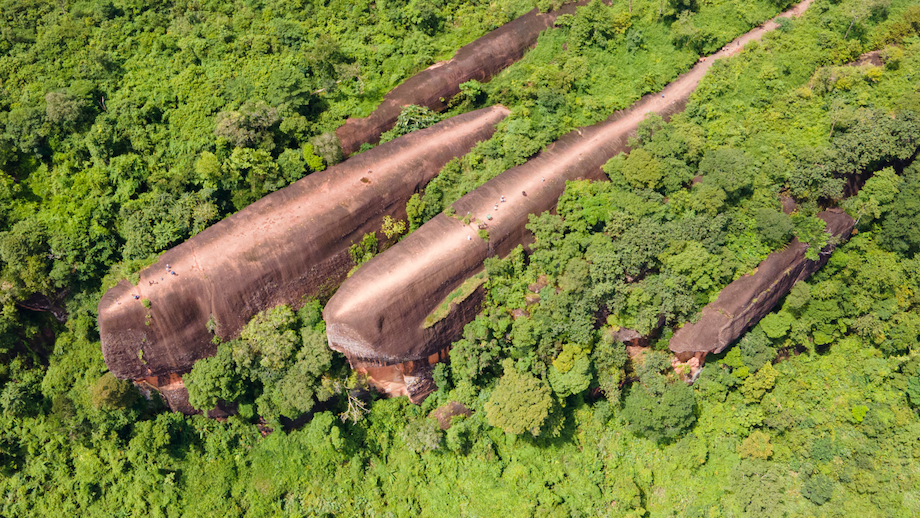Thailand’s Three Whale Rock: A Geological Marvel Emerges from the Forest
Deep in the lush, lesser-traveled northeast of Thailand, a trio of colossal stone formations rises from the emerald canopy, capturing the imagination of all who see them. Known as Hin Sam Wan, or Three Whale Rock, these ancient boulders resemble a family of whales swimming side by side, their massive forms jutting out over the treetops as if breaching an ocean of green. But beyond their striking appearance, the Three Whale Rocks tell a story of deep time, cultural reverence, and the growing movement for sustainable tourism in Thailand’s Bueng Kan province.
- Thailand’s Three Whale Rock: A Geological Marvel Emerges from the Forest
- How Did Three Whale Rock Form? The Science Behind the Stone Leviathans
- Where Is Three Whale Rock? Exploring Bueng Kan’s Hidden Gem
- Three Whale Rock and the Rise of Sustainable Tourism in Thailand
- Beyond the Whales: The Riches of Phu Sing Forest Park
- Why Three Whale Rock Captivates the Imagination
- In Summary
How Did Three Whale Rock Form? The Science Behind the Stone Leviathans
The Three Whale Rock formation is estimated to be around 75 million years old, dating back to the late Cretaceous period—a time when dinosaurs still roamed the Earth. The rocks are composed primarily of sandstone, a sedimentary rock formed from compacted sand and minerals over millions of years. This region, known as the Khorat Plateau, is one of Thailand’s oldest geological landscapes, rich in fossils and evidence of prehistoric life.
The formation of the whale-like boulders is the result of a slow, relentless process. Over eons, tectonic uplift raised the sedimentary layers, exposing them to the elements. Wind, rain, and temperature fluctuations gradually eroded the softer material, while cracks and fissures in the rock guided the sculpting process. What remains today are three elongated, rounded boulders—each hundreds of meters long—perched on a high ridge above the forest. Their smooth, organic contours and the way they seem to float above the canopy create the uncanny illusion of whales gliding through a sea of trees.
As one geology enthusiast described in an online forum,
“These magnificent structures are estimated to be over 75 million years old, a staggering age that predates the dinosaurs’ final extinction. They were not created in a sudden cataclysm, but rather sculpted patiently by the elements.”
The result is a natural masterpiece that blurs the line between geology and art.
Where Is Three Whale Rock? Exploring Bueng Kan’s Hidden Gem
Three Whale Rock is located in Phu Sing Forest Park, part of the Phu Sing mountain range in Bueng Kan province. This region, bordering Laos and the Mekong River, is one of Thailand’s most remote and least-visited areas, making it a haven for those seeking tranquility and authentic natural beauty. The park itself is a protected area, home to diverse flora and fauna, waterfalls, and other unique rock formations such as Elephant Rock and the Hermit’s Cave.
From the nearest town of Bueng Kan, the journey to Three Whale Rock takes about 30 minutes by car or scooter. Visitors register at the park entrance, where they can choose to hike to the top—a moderate trek of about 45 minutes to an hour—or hire a jeep for a guided tour. The route winds through dense forest, past animal-shaped rocks and panoramic viewpoints, before emerging onto the spine of the largest “whale.”
Only the two largest rocks, affectionately known as the “father” and “mother” whales, are accessible to visitors. The smallest, the “baby” whale, is closed to the public to protect its fragile surface. From the top, the views stretch across the Isan countryside, the Mekong River, and into the mountains of Laos’ Pakkading district. The sensation of standing atop these ancient leviathans, with sheer drops on three sides and the forest stretching to the horizon, is both exhilarating and humbling.
Visitor Experience: What to Expect at Three Whale Rock
The Three Whale Rock experience is designed to balance accessibility with conservation. The park is open daily from 5 AM to 5 PM, with an entrance fee of 100 baht per person. Jeep rides to the top cost 500 baht, which can be shared among groups. Facilities include toilets at the base and summit, food stalls, and a coffee shop. Safety zones are clearly marked, though visitors should be mindful of the high platforms and lack of handrails in some areas.
Many travelers describe the site as a hidden gem, far removed from Thailand’s crowded tourist hotspots. The atmosphere is lively yet respectful, with Thai families, photographers, and nature lovers all drawn to the site’s unique beauty. Sunrise and sunset are particularly magical times to visit, as the light bathes the rocks in golden hues and the landscape comes alive with birdsong.
Three Whale Rock and the Rise of Sustainable Tourism in Thailand
As Thailand welcomes millions of international visitors each year, the challenge of balancing tourism with environmental preservation has become increasingly urgent. Overtourism can damage fragile ecosystems and disrupt local communities, prompting a nationwide push for more sustainable travel practices.
Bueng Kan province, with its pristine landscapes and cultural richness, has become a model for eco-friendly tourism. The Tourism Authority of Thailand (TAT) launched the “7 Greens” initiative in 2011, encouraging responsible travel and the protection of natural treasures like Three Whale Rock. Visitors are urged to respect the environment, minimize waste, and engage with local culture in meaningful ways.
One standout example is the Life Community Museum in Bueng Kan, a collaborative project that showcases Isan traditions, architecture, and art. The museum offers immersive experiences—such as local markets, live music, and Buddhist handicraft exhibits—without intruding on daily life. This approach not only preserves cultural heritage but also provides economic opportunities for local families.
Conservation and Community: Protecting a Natural and Cultural Legacy
Three Whale Rock is more than a geological curiosity; it is a site of deep cultural significance for the people of Bueng Kan. Local legends and spiritual practices are woven into the landscape, with the rocks regarded as guardians and symbols of resilience. Pilgrims and visitors alike ascend the whales not just for the views, but to offer prayers and connect with a sense of timelessness.
The park’s protected status ensures that both the natural environment and its cultural traditions are safeguarded for future generations. Community involvement is central to this effort, with local guides, artisans, and rangers all playing a role in managing tourism and maintaining the site’s integrity.
Beyond the Whales: The Riches of Phu Sing Forest Park
While Three Whale Rock is the star attraction, Phu Sing Forest Park offers much more for adventurous travelers. The park boasts nine hiking routes, each revealing different facets of the region’s biodiversity and geological wonders. Waterfalls, caves, and other animal-shaped rocks dot the landscape, providing endless opportunities for exploration and photography.
The area is home to a wide variety of plant and animal life, including exotic birds, butterflies, and rare orchids. The forest itself is a living museum, with ancient trees and diverse ecosystems that have survived for millions of years. For those seeking a deeper connection with nature, the park’s tranquil trails and scenic viewpoints offer a welcome escape from the bustle of modern life.
Practical Tips for Visiting Three Whale Rock
- Getting There: Bueng Kan is about 720 km from Bangkok. The nearest town is Bueng Kan City, 24 km from the park entrance.
- Best Time to Visit: The cool season (November to February) offers mild weather and clear skies, ideal for hiking and photography.
- Accessibility: The park is suitable for most visitors, with jeep tours available for those who prefer not to hike.
- Facilities: Toilets, food stalls, and a coffee shop are available at the base and summit. Safety zones are marked, but caution is advised near cliff edges.
- Respect the Site: Follow park rules, stay on marked paths, and avoid disturbing wildlife or leaving litter.
Why Three Whale Rock Captivates the Imagination
What makes Three Whale Rock so compelling is not just its visual resemblance to a family of whales, but the sense of wonder it inspires. Standing atop these ancient stones, visitors are reminded of the immense timescales and natural forces that shape our planet. The rocks are a living testament to the power of erosion, the patience of geological processes, and the interconnectedness of nature and culture.
As one travel writer put it,
“The experience of standing atop the whales transcends simple sightseeing; it’s an immersion into a story written in stone, where the grandeur of nature meets the quiet reverence of human spirit.”
For many, the journey to Three Whale Rock is as much a pilgrimage as a hike—a chance to reflect on the passage of time and our place within the natural world.
In Summary
- Three Whale Rock (Hin Sam Wan) is a 75-million-year-old sandstone formation in Bueng Kan, northeast Thailand, resembling a family of whales.
- The rocks formed through millions of years of erosion and tectonic uplift, creating a unique geological landmark on the Khorat Plateau.
- Located in Phu Sing Forest Park, the site offers hiking trails, panoramic views, and a tranquil escape from mass tourism.
- Only the two largest rocks are accessible to visitors; the smallest is protected to preserve its fragile surface.
- Three Whale Rock is a symbol of both natural wonder and cultural significance, revered by local communities and protected as a heritage site.
- Bueng Kan province promotes sustainable tourism, balancing visitor access with environmental and cultural preservation.
- Phu Sing Forest Park features diverse wildlife, waterfalls, and other rock formations, making it a must-see for nature lovers and adventurers.
- Visitors are encouraged to respect the site, support local communities, and embrace responsible travel practices.




